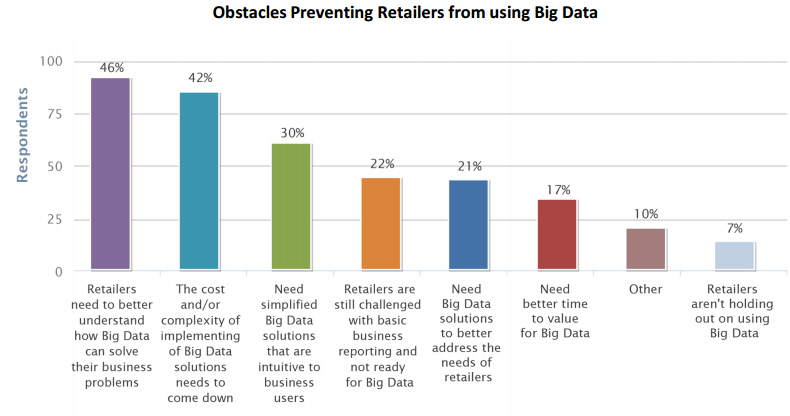Retailers know they need Big Data and are charging forward to get in the game. But many retailers continue to face challenges. What type of data should be collected? How should the data be used to generate insights? How do I measure ROI?
101data recently surveyed US retailers, across a range of sizes. When asked about which processes would be most impacted by Big Data technology, 50% stated that targeted offers and promotions would have the biggest impact. Responses included:
- 50% – Targeted offers and benefits
- 49% – Demand forecasting and supply chain modeling
- 43% – Customer-centric merchandising
- 35% – Loyalty program management
However, while retailers see the potential, many are holding back on implementing Big Data initiatives. The biggest reasons cited were that retailers need to better understand how Big Data can solve their business problems (46%) and the cost of complexity of implementing Big Data solutions needs to come down (42%).

Nevertheless, retailers still believe Big Data is important for staying competitive. Most of the respondents categorized Big Data initiatives as “important” (38%), followed by “very important” (35%), or “moderately important” (23%), with just 4% stating that Big Data initiatives are of little importance or unimportant.

Big Data is not an “out of the box” solution. It involves some creativity and an understanding of the business challenges you want to solve.
Data-as-a-Service is increasingly being used by retailers in marketing to harness Big Data insights – and without the heavy investment in a Big Data implementation. DaaS is a service approach in which a vendor sources unique and Hard-to-Find data from the Big Data ecosystem. This data is then structured to deliver a constant stream of in-market shoppers who are actively searching for products a retailer (or their competitors) are selling. Retailers can target shoppers with immediate, relevant offers, such as dynamic pricing, personalized recommendations, shopper-specific discounts and more.
How DaaS Delivers In-Market Shoppers
DaaS combines three types of data which are uniquely customized to each company:
- Foundational Data:
Internal data combined with additional demographic and firmographic enhancement and specialty data. These specialty data sets have been aggregated from hundreds of Big Data sources and go well beyond third party lists. As an example, these may be highly specialized sources of furniture or fashion interests, or spend data on specific businesses by categories. - Onboarded Data:
Offline data transformed into addressable online identities. Onboarding provides new opportunities to reach customers and prospects in the digital universe. For example, targeted display campaigns can be displayed to specific customer and prospect segments. A specialty retailer company may want to target key customer groups with display ads that cross-sell another product. Or an auto dealer may show ads to people whose leases are up for renewal. - Fast Data:
Real-time behavioral data. Fast Data aggregates event and behavioral-driven data to determine purchase intent as it occurs. Examples may include social purchase signals, such as People posting to social networks such as “Excited about the new baby” or “Taking a family vacation.” Or these may be discretionary purchase power signals, such as customers and prospects who are securing new credit sources, selling and buying cars or planning to move residences.

When retailers have access to key data insights (like in the above image), they become especially equipped to send targeted offers and benefits to prospects or customers. Surprisingly enough, this data can easily be integrated into a retailer’s CRM system, marketing platform, or other data management platforms. DaaS makes big data accessible! (And easy to use.) Retailers can harvest data that is relevant and important to them on social media networks, like Twitter, based on keyword searches, like ‘Furniture’.
DaaS doesn’t stop there. There are endless opportunities for retailers to receive data from almost any source. This could include social media, but in many cases, it stretches far beyond social media unto web searches, public records and online or offline transactional activity (to name a few). Big data is the accumulation of opportunities brought to you by data, and DaaS is the key to these opportunities.
To learn more about Data-as-a-Service, download our free solutions guide.

This article was syndicated from Business 2 Community: How to Use Big Data to Acquire New Customers
More Technology & Innovation articles from Business 2 Community:




